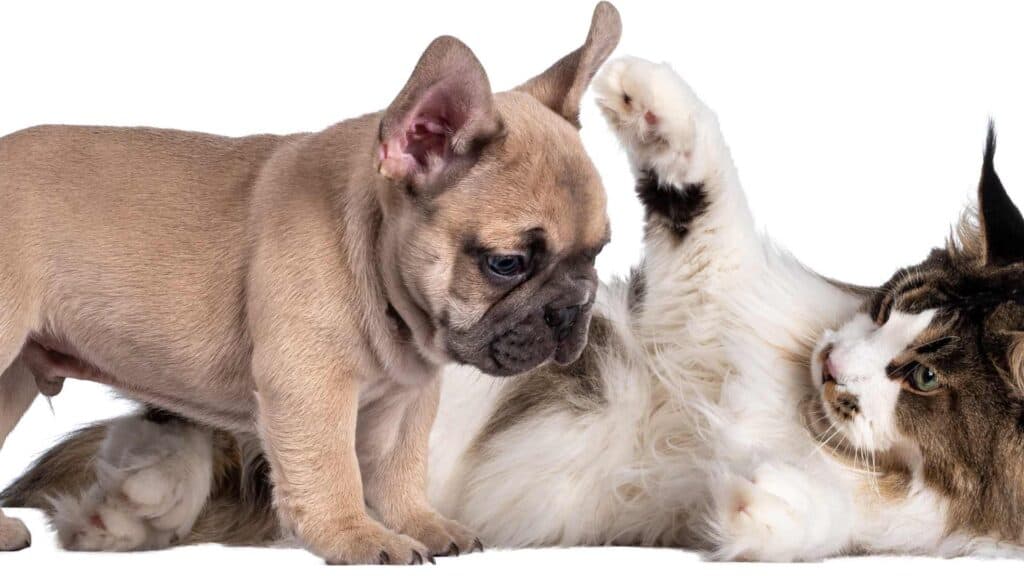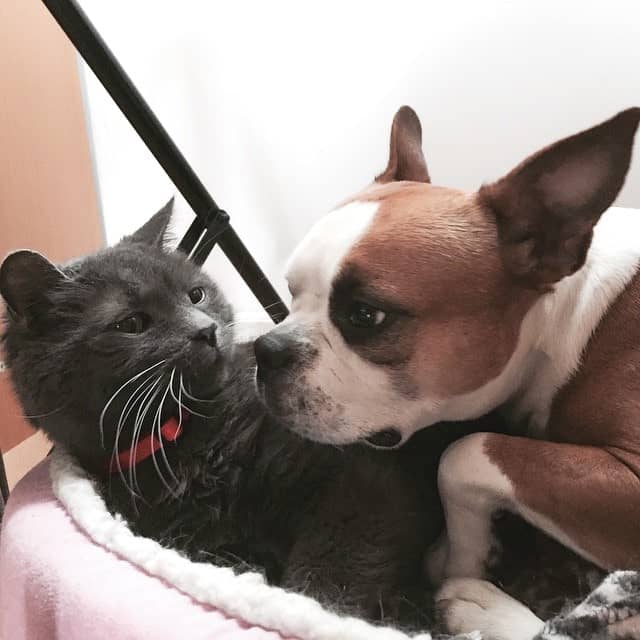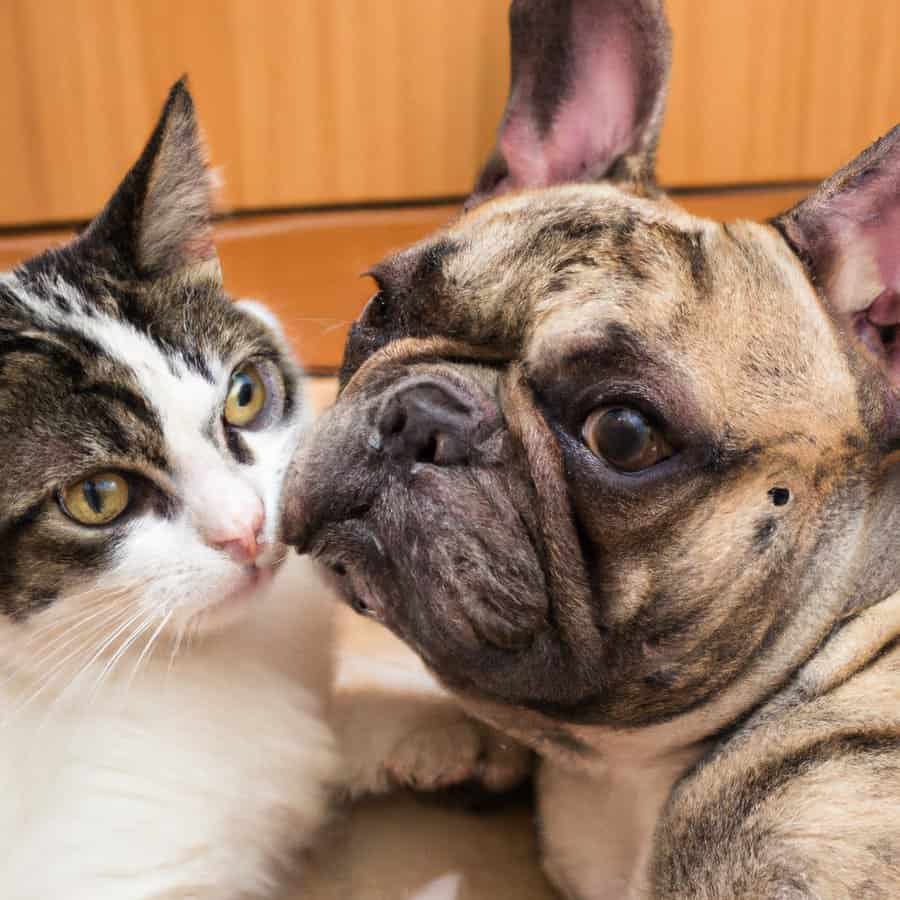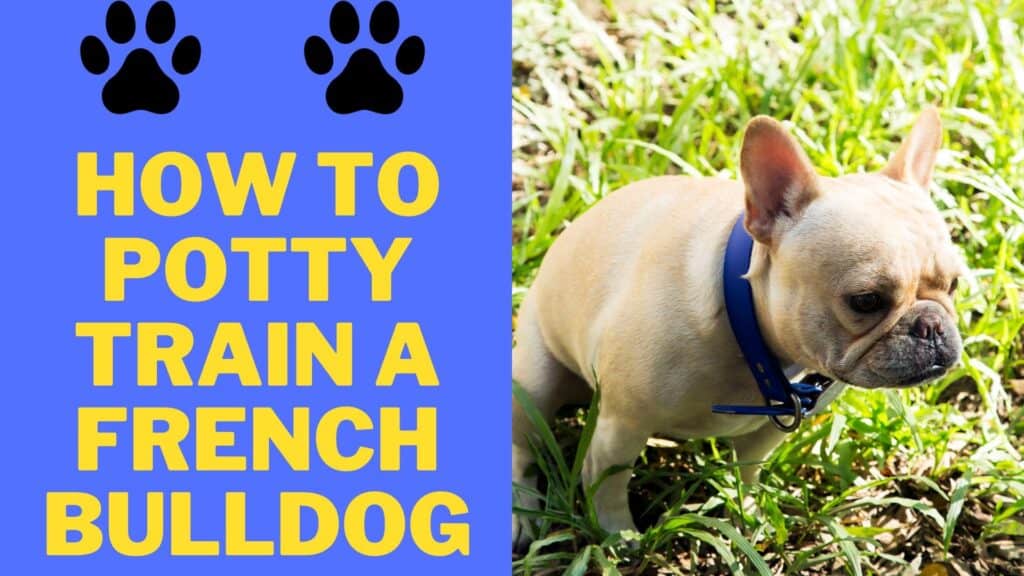Are French bulldogs good with cats?
Well, they can be if you smoothly and safely introduce your Frenchie to your cat.
All dogs and cats are different.
Learning about their posture reading and looking for signs of any danger while introducing them can help you build their relationship strong.
In this guide, I will tell you how to build a strong bond between your Frenchie and cat.
So, let’s dive in and ensure you don’t miss anything important.
History Of The Cat And Dog Relationship
The cat and dog relationship is a long and complicated one.
It is believed that the first domesticated cats were in ancient Egypt, around 4,000 years ago.
The Egyptians revered these cats and were often seen as gods.
Cats were so crucial to the Egyptians that they even had a goddess, Bastet, who was represented as a cat.
Cats and dogs didn’t always get along, though.
There is evidence that suggests that early humans hunted cats for their fur.
This likely led to a lot of conflict between the two species.
It wasn’t until recently that cats and dogs started to become friends.
In the 1800s, Queen Victoria of England owned both cats and dogs.
She is credited with helping to improve the relationship between the two species.
Nowadays, many people have both cats and dogs living together harmoniously.

What’s In This Guide?
This guide will cover everything you need to know to build a successful relationship with your frenchie and cat.
Some leading topics like what should I do if they don’t get along? Or their relationship benefits and many more things I will explain to you in this article.
My Personal Experience On French Bulldog Temperament With Cats
Despite my owning a frenchie, my sister owns a cat.
During that time, my sister was in college, and my frenchie and cat were also apart, so they were both big when we introduced them.
After completing her graduation in 2022, my sister came back home.
The first look on both of their faces was of aggression, and they were not ready to stay under the same roof.
I was worried that someone would get hurt.
So, I researched through the internet and consulted professionals to improve their relationship.
In this article, I have described all the guides I have followed and some of the research steps I took.
The best method is to treat them on their behavior while they are together.
After about 7-8 months, we can leave them alone without any worry they sometimes fight, but not aggressively it’s natural.
You may like: How To Potty Train A French Bulldog
Preparing For The First Introduction
When introducing your French Bulldog to a cat for the first time, you should do a few things to ensure a positive experience.
First, ensure the area where the introduction will take place is calm and free of distractions.
Next, allow the cat to approach the French Bulldog on its terms; do not force either animal to interact.
Be prepared to intervene if either animal becomes scared or aggressive.
By following these simple steps & which I have given below, you can ensure that your French Bulldog and cat have a happy and safe meeting.
Plan The Introduction
Planning the introduction between your French Bulldog and cat is crucial for successful integration.
Take the time to think through this critical step, as it sets the tone for their future relationship.
First, consider the timing of the introduction.
Choose a calm and quiet moment when both pets are relaxed and not distracted.
Avoid introducing them during feeding times or when they may be territorial.
Choosing A New Cat To Meet My Frenchie
When selecting a cat, it’s crucial to consider their temperament and compatibility with dogs.
Look for a cat known to be friendly, pleasant, and adaptable.
Consider the age of the cat as well.
Younger cats are more open-minded and can adjust to living with your frenchie compared to an older one who may have established habits or preferences.
Dog And Cat-Friendly Area
Create a dog and cat-friendly area in your home where they can start getting acquainted. This could be a separate room with their food bowls, litter box, toys, and bedding.
By initially providing each pet with its own space, you’ll allow them to adjust at their own pace without feeling threatened.
Buy Treats & Toys
Before bringing your new cat home, stock up on treats and toys that both pets enjoy.
These will come in handy during the introduction process as positive reinforcement tools.
Use treats to reward good behavior from both pets when they’re near each other or showing signs of curiosity without aggression.
Leash And Harness
The leash and harness for your frenchie are also crucial for controlled introductions outside designated areas.
This will give you peace of mind knowing that if tensions arise between them during initial encounters outdoors, such as walks.
You can easily separate them while keeping control over your Frenchie.
Preparing Home For Introduction
To prepare your home for the introduction, make sure there are plenty of high perches or hiding spots available for the cat to escape if needed.
Ensure that all doors leading into rooms are closed so neither pet feels overwhelmed by too much territory at once.
How to introduce French Bulldogs to Cats?
If you’re considering adding a french bulldog to your home, you may wonder if they are good with cats.
The answer is that it depends.
Some french bulldogs get along famously with felines.
While others may view them as nothing more than prey.
However, there are some steps you can take to increase the chances of your french bulldog and cat becoming best friends.
Bring in a Barrier Or Crate On The First Few Days
One of the best ways to ensure a smooth introduction between your French Bulldog and your cat is by bringing in a barrier or crate during the first few days.
This will create a physical boundary allowing both pets to see and smell each other without direct contact.
By using a barrier or crate, you are providing a controlled environment for the initial interactions.
This can help alleviate any potential aggression or fear from either pet.
It also gives them time to adjust to each other’s presence without feeling overwhelmed.
During this period, observe their behavior closely.
Look for signs of curiosity, such as sniffing around the barrier or showing interest in each other’s toys and treats.
It’s important not to rush the process; let them set their own pace.
Observe And Slowly Remove the Barrier
As they start getting used to seeing each other through the barrier, gradually remove it for short periods under supervision.
This allows them to interact more directly while having an escape route if needed.
Create Favorable Environment
Creating a favorable environment is crucial during these early stages.
Make sure plenty of resources are available for both pets, such as separate food bowls, litter boxes, and comfortable resting areas.
Give More Attention Toward Your Cat
Cats are known for their independent nature but enjoy being the center of attention.
Set aside daily quality time to lavish love and care for your cat.
Engage in play sessions with their favorite toys or indulge in some relaxing grooming time.
Providing extra attention to your cat reinforces their importance within the family unit and reassures them that they have not been replaced.
This can help alleviate jealousy or insecurity when introducing a new pet.
Start With a Neutral Ground
This means choosing a location where neither pet feels territorial or possessive.
It could be a room both pets haven’t spent much time in or an outdoor space like the backyard.
Allowing them to sniff and explore the area before their initial interaction can help ease any tension or anxiety they may feel.
Remember that cats are typically more cautious and sensitive to environmental changes.
So it’s essential to create a calm and peaceful setting.
Praise Them
Praising your French Bulldog and cat during their introduction is essential in fostering a positive environment for both.
By offering praise, you can reinforce good behavior and help build trust between the two animals.
When they display calm and relaxed behavior around each other, shower them with praise.
Use a gentle tone of voice to let them know they are doing well.
You can say things like “Good boy!” or “Good girl!” with a soothing voice.
Problems And Warning Signs
Aggression or excessive chasing behaviors can be a red flag.
If your Frenchie shows signs of aggression towards your cat, such as growling, lunging, or snapping, it’s crucial to address this behavior immediately.
Seek professional help from a trainer or behaviorist who specializes in dog-cat introductions.
Another problem that may arise is fear or anxiety in the Frenchie or the cat.
Some dogs may become fearful of cats due to past negative experiences or simply because they are unfamiliar with them.
Similarly, some cats may feel threatened by the presence of a new dog in their territory.
Watch for signs of stress such as hiding, hissing, raised fur on the back, excessive meowing (in cats), panting (in dogs), or pacing.
Relaxation is key
Start by ensuring that you are in a peaceful state of mind before beginning the introduction.
Take deep breaths and try to release any anxiety or nervousness you may be feeling.
Your pets will pick up on your energy, so setting the tone for a positive experience is crucial.

Learn Posture Reading in Both Cats and French Bulldogs
One of the first things you should consider is whether a French Bulldog is a good fit for your home.
Learn about posture reading in both cats and French Bulldogs.
By understanding the body language of both animals, you’ll be able to gauge better how they’re feeling around each other and whether or not they’re likely to get along.
Here are some key things to look for:
Cats
A cat’s ears will be up and alert if it’s feeling happy and relaxed.
If a cat’s ears are back or flattened against its head.
That’s usually a sign that it’s feeling threatened or uncomfortable.
French Bulldogs
A French Bulldog’s tail can also give you clues about its mood.
If a Frenchie’s tail is wagging, it’s usually a good sign that it’s happy and friendly.
But if a Frenchie’s tail is between its legs or standing straight up, it usually means feeling scared or anxious.
Why Cats And Dogs Don’t Get Along?
Dogs and cats have different instincts, communication styles, and territorial behaviors.
Here are some reasons why dogs and cats don’t get along.
Predatory Instincts
Cats and dogs have different instincts that can sometimes clash.
Dogs, mainly breeds with a strong prey drive like French Bulldogs, may see cats as potential prey due to their small size and quick movements.
On the other hand, cats are often wary of larger animals and may feel threatened by an energetic dog’s presence.
Communication
Cats and dogs also communicate in different ways.
Dogs use barking, tail wagging, and body language to express themselves, while cats rely more on subtle facial expressions and body postures.
This difference in communication styles can lead to misunderstandings between two species.
Territoriality
Both cats and dogs are territorial creatures by nature.
They mark their territories with scents or urine to establish boundaries.
Introducing a new pet into their space can trigger territorial behavior, such as hissing or growling from cats or an excessive dog barking.
Personalities
Like humans, animals have unique personalities that can affect how they get along with others.
Some cats may be more tolerant of dogs, while others might be fearful or aggressive towards them.
Similarly, some dogs may be friendly toward cats, while others view them as threats.
Socialization and past experiences
Early socialization plays a crucial role in how well pets interact with each other later in life.
If cats have had negative experiences with dogs, they are likely to be more cautious or defensive around them.
Likewise, if a dog has been properly socialized around cats during puppyhood, they tend to be more accepting of feline companions.
What Should I Do If They Don’t Get Along?
So, you’ve followed all the steps and introduced your French Bulldog to your cat.
Things are not going as smoothly as you had hoped.
Don’t worry – it’s not uncommon for dogs and cats to adjust to each other’s presence.
It’s important not to panic or force interactions between them.
Give them both space and time to acclimate at their own pace.
Rushing the process can make matters worse.
Next, consider seeking professional help from a trainer or animal behaviorist specializing in inter-species relationships.
They can provide valuable guidance on addressing any issues that arise.
In the meantime, continue providing separate spaces for your frenchie and cat when necessary.
This will allow them both to feel secure in their territories without feeling threatened by each other.
Additionally, keep a close eye on their body language and behaviors during supervised interactions.
Look for stress or aggression from either party, such as raised fur, growling, hissing, or excessive barking.
If these behaviors persist or escalate over time, consulting with a professional for further assistance may be necessary.
Remember that every dog-cat relationship is unique and may require different approaches.
Patience is critical here – give them plenty of time and opportunities to build trust and familiarity with one another gradually.
Building positive associations through rewards can also help improve their relationship over time.
Reward calm behavior from your frenchie and cat whenever they are near each other without displaying signs of aggression or fear.
Managing a situation where your French Bulldog doesn’t get along with your cat requires patience, observation, and possibly professional intervention if needed.

What About Other People’s Cats On Walks?
One common concern when introducing your French Bulldog to cats is how they react to other people’s cats while on walks.
It’s important to remember that not all cats are comfortable around dogs.
So, what should you do if you encounter another person walking their cat?
First of all, it’s crucial to respect the space of other pet owners.
Keep a safe distance between your Frenchie and any unfamiliar feline companions.
This will help prevent any potential conflicts or stress for both animals.
If the cat seems curious or approaches your dog, observe their body language closely, a stiff tail, raised fur, or hissing from the cat may indicate discomfort or fear.
In such cases, calmly redirect your dog’s attention away from the cat and continue walking.
Remember that every situation is unique and requires careful judgment.
Try to communicate with the other pet owner before approaching too closely with your dog.
They may have valuable insights into their cat’s behavior around dogs.
Being considerate and attentive during these encounters can minimize any potential tension between your Frenchie and other people’s cats during walks.
Benefits Of Introducing A Frenchie And A Cat
A French Bulldog can provide more than mere companionship when introduced to a cat.
They foster a family dynamic that promotes responsible pet ownership.
By fostering laughter, comfort, diversity in affection styles, and reduced separation anxiety levels in dogs.
The Road To An Established Team
Building a harmonious relationship between your French Bulldog and your cat requires time.
Patience and understanding.
It may not happen overnight, but you can create an established team of furry friends with the right approach, which I have explained in this article.
What To Do After The Introduction And Longer Term?
Now that you have successfully introduced your French Bulldog and cat.
It’s important to continue fostering a positive relationship between them in the long term.
Here are some steps you can take to ensure their ongoing harmony.
1. Gradual Integration: Allow your Frenchie and cat to spend more time together gradually.
Start with supervised visits and gradually increase the duration of their interactions.
This will help them become familiar with each other’s presence without feeling overwhelmed.
2. Separate Spaces: It’s crucial to provide separate spaces for your Frenchie and cat within your home.
Each pet should have designated areas where they feel safe and secure.
Complete with separate food bowls, beds, litter boxes, or potty pads.
3. Supervised Playtime: Encourage supervised play sessions between your Frenchie and cat using interactive toys they enjoy.
These sessions promote bonding while keeping them engaged in a positive activity.
4. Consistency is Key: Maintain consistency in your daily routines for feeding, exercise, and playtime with both pets.
This helps establish a sense of stability for them and reinforces positive associations.
5. Positive Reinforcement: Continue rewarding good behavior from both pets with treats, praise, or affection whenever they interact peacefully or show signs of acceptance towards one another.
6. Respect Boundaries: There may still be moments when your Frenchie or cat wants space or prefers solitude.
Respect these boundaries by allowing them uninterrupted alone time when needed.
Getting Used To Each Other
Patience is key when getting your French Bulldog and cat to coexist peacefully.
The initial introduction is just the beginning of a journey toward building a harmonious relationship.
Dogs and Cats Learn to Understand Each Other
Just like humans, dogs and cats have their unique ways of communication.
Over time, they will learn to understand each other’s body language and cues.
Encourage positive interactions by providing treats or playtime whenever they exhibit friendly behavior towards one another.
Alone Together
Give your frenchie and cat plenty of alone time together in a controlled environment where you can closely monitor their interactions.
This allows them to form their bond without feeling overwhelmed or threatened.
Final Thoughts On French Bulldogs And Cats
Understanding your dog and cat behavior can help a lot.
Just dont force things to do faster.
Giving a treat on their behavior can also develop good habits.
Are French Bulldogs Good With Cats? Yes, they are and can build a healthy relationship if you put some effort into teaching them behavior habits.
So, when are you putting effort into building relations between your frenchie and cat, and which step do you like most make sure to comment below.
FAQ
Which Dogs Are Good With Cats?
Dog’s nature is good, However, each dog has its behavior and aggressive temperaments.
Dogs such as golden retrievers, labradors, bichons frise, boxers, pugs, and collies, including frenchie, are the best dogs in nature with other pets.
Will My Cat Get Along With A French Bulldog?
The answer is yes, as long as you introduce them slowly and safely and allow them to have their own space.
Do French Bulldogs And Cats Have A Good Relationship?
If you put in some effort and teach them good behavior habits, french bulldogs and cats can have a healthy relationship.
Are French Bulldogs Aggressive With Cats
Well, that depends on your dog’s behavior.
Untrained dogs might attack cats, but developing positive habits can have the opposite effect.


